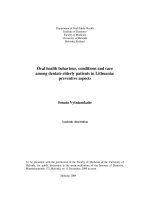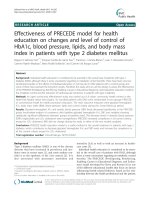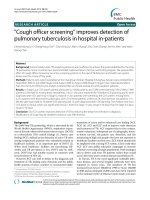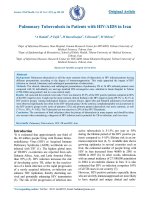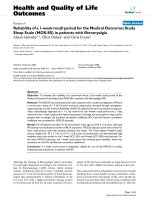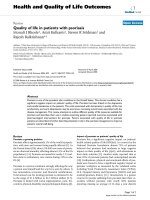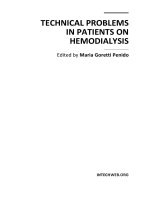TECHNICAL PROBLEMS IN PATIENTS ON HEMODIALYSIS pptx
Bạn đang xem bản rút gọn của tài liệu. Xem và tải ngay bản đầy đủ của tài liệu tại đây (10.09 MB, 312 trang )
TECHNICAL PROBLEMS
IN PATIENTS ON
HEMODIALYSIS
Edited by Maria Goretti Penido
Technical Problems in Patients on Hemodialysis
Edited by Maria Goretti Penido
Published by InTech
Janeza Trdine 9, 51000 Rijeka, Croatia
Copyright © 2011 InTech
All chapters are Open Access distributed under the Creative Commons Attribution 3.0
license, which allows users to download, copy and build upon published articles even for
commercial purposes, as long as the author and publisher are properly credited, which
ensures maximum dissemination and a wider impact of our publications. After this work
has been published by InTech, authors have the right to republish it, in whole or part, in
any publication of which they are the author, and to make other personal use of the
work. Any republication, referencing or personal use of the work must explicitly identify
the original source.
As for readers, this license allows users to download, copy and build upon published
chapters even for commercial purposes, as long as the author and publisher are properly
credited, which ensures maximum dissemination and a wider impact of our publications.
Notice
Statements and opinions expressed in the chapters are these of the individual contributors
and not necessarily those of the editors or publisher. No responsibility is accepted for the
accuracy of information contained in the published chapters. The publisher assumes no
responsibility for any damage or injury to persons or property arising out of the use of any
materials, instructions, methods or ideas contained in the book.
Publishing Process Manager Masa Vidovic
Technical Editor Teodora Smiljanic
Cover Designer InTech Design Team
Image Copyright Barghest, 2011. Used under license from Shutterstock.com
First published November, 2011
Printed in Croatia
A free online edition of this book is available at www.intechopen.com
Additional hard copies can be obtained from
Technical Problems in Patients on Hemodialysis, Edited by Maria Goretti Penido
p. cm.
ISBN 978-953-307-403-0
free online editions of InTech
Books and Journals can be found at
www.intechopen.com
Contents
Preface IX
Chapter 1 Bedside Linear Regression Equations to Estimate
Equilibrated Blood Urea 1
Elmer A. Fernández, Mónica Balzarini and Rodolfo Valtuille
Chapter 2 Hemodialysis Access: The Fistula 17
Mary Hammes
Chapter 3 The Brachio-Brachial Arteriovenous Fistula 35
Lucian Florin Dorobanţu, Ovidiu Ştiru, Cristian Bulescu,
Şerban Bubenek and Vlad Anton Iliescu
Chapter 4 Vascular Access for Hemodialysis 45
Konstantinos Pantelias and Eirini Grapsa
Chapter 5 Subjective Well-Being Measures
of Hemodialysis Patients 69
Paulo Roberto Santos
Chapter 6 Hemodialysis Access Infections, Epidemiology,
Pathogenesis and Prevention 87
Nirosha D. Gunatillake, Elizabeth M. Jarvis and David W. Johnson
Chapter 7 Acute and Chronic Catheter in Hemodialysis 107
Andrew S. H. Lai and Kar Neng Lai
Chapter 8 Complex Wounds in Patients Receiving Hemodialysis 121
Masaki Fujioka
Chapter 9 Specifications of the Quality of Granulated Activated
Charcoal Used in Water Systems Treatment in
Hemodialysis Centers in Brazil 147
Eden Cavalcanti Albuquerque Júnior,
Marcos Antonio de Souza Barros, Manoel O. Mendez,
Aparecido R. Coutinho and Telma T. Franco
VI Contents
Chapter 10 Bioimpedance Measurement
in the Kidney Disease Patient 165
Joëlle Cridlig, Mustapha Nadi and Michèle Kessler
Chapter 11 Management of Fluid Status in Haemodialysis Patients:
The Roles of Technology and Dietary Advice 185
Elizabeth Lindley, Lynne Aspinall,
Claire Gardiner and Elizabeth Garthwaite
Chapter 12 Cell-Free Nucleic Acids as Biomarkers of
Biocompatibility in Dialytic Process 199
Marie Korabečná
and Aleš Hořínek
Chapter 13 Measuring System of Urea in Blood by Application
in Recirculation for Hemodialysis Treatment 215
G.A. Martinez
Chapter 14 Acetate Free Biofiltration with
Potassium Profiled Dialysate (AFB-K) 227
R.I. Muñoz, I. Gallardo and J. Montenegro
Chapter 15 Blood Volume Regulation 235
Roland E. Winkler, Fabio Grandi and Antonio Santoro
Chapter 16 Acute Complications of Hemodialysis 251
Gülsüm Özkan and Şükrü Ulusoy
Chapter 17 Review of the Effectiveness of Cellulose-
and Polysulfone-Based Vitamin E-Bonded
Dialysis Membranes 295
Masaharu Aritomi and Francesco Galli
Preface
This book provides an overview of technical aspects in treatment of hemodialysis
patients. Authors have contributed their most interesting findings in dealing with
hemodialysis from the aspect of the tools and techniques used.
Each chapter has been thoroughly revised and updated so the readers are acquainted
with the latest data and observations in the area, where several aspects are to be
considered. The book is comprehensive and not limited to a partial discussion of
hemodialysis. To accomplish this we are pleased to have been able to summarize state
of the art knowledge in each chapter of the book.
This book provides practical and accessible information. It is quite comprehensive as it
covers various established as well as emerging techniques and equipment. We wish to
thank each author for taking considerable time and effort to ensure their chapter
provides state of the art information. We hope that readers achieve the same level of
acquisition of new knowledge as we have attained by editing this book.
Dr. Maria Goretti Penido
Department of Pediatrics
School of Medicine
Federal University of Minas Gerais
Minas Gerais
Brasil
1
Bedside Linear Regression Equations to
Estimate Equilibrated Blood Urea
Elmer A. Fernández
1,2
, Mónica Balzarini
2,3
and Rodolfo Valtuille
4
1
Faculty of Engineering, Catholic University of Córdoba
2
National Council of Scientific and Technological Research (CONICET)
3
Biometry Department, National University of Córdoba
4
Fresenius Medical Care
Argentina
1. Introduction
Three decades ago Sargent and Gotch established the clinical applicability of Kt/V, a
dimensionless ratio which includes clearance of dialyzer (K),duration of treatment(t) and
volume of total water of the patient (V), as an index of Hemodialysis (HD) adequacy (Gotch
& Keen, 2005). This parameter, derived from single-pool(sp) urea(U) kinetic modelling, has
become the gold standard for HD dose monitoring and it is widely used as a predictor of
outcome in HD populations (Locatelli et al., 1999; Eknoyan et al., 2002; Locatelli, 2003).
However, this spKt/V overestimates the HD dose because it does not take into account the
concept of U rebound (UR). UR begins immediately at the end of HD session and it is
completed 30-60 minutes after. UR is related to disequilibriums in blood/cell compartments
as well as the flow between organs desequilibriums, both produced during HD treatment.
Therefore, equilibrated (Eq) Kt/V is the true HD dose and it requires the measurement of a
true eqU when UR is completed. A blood sample to obtain an eqU concentration has several
drawbacks that make this option impractical (Gotch and Keen,2005). For this reason in the
last decade several formulas were developed to predict the eqU and also (Eq) Kt/V
eliminating the need of waiting for a equilibrated urea mesurement. For instance, the “rate
formula” (Daurgidas et al., 1995) is the most popular and validated equation. It is based in
the prediction of (Eq)Kt/V as a linear function of (sp)Kt/V and the rate of dialysis(K/V).
Another approach has been proposed by Tattersall, a robust formula based on double–pool
analysis (Smye et al.1999). However, spite this eqU prediction approach is conceptually
rigorous, it is not accurate (Gotch, 1990; Guh et al., 1999; Fernandez et al., 2001).
Consequently, the availability of a model to predict subject-specific equilibrated
concentration will be very helpful.
Although the behaviour of urea is non-linear since its extraction from blood follows some
exponential family model as a function of time, we found that prediction of its equilibrated
concentration after the end of the treatment session by means of linear models is accurate. In
this study, we have shown how to build linear models to predict equilibrated urea based on
two statistical procedures and a machine learning method that can be implemented in
hemodialysis centres. The fitted model can be used for daily treatment monitoring and is
Technical Problems in Patients on Hemodialysis
2
easily implemented in common available spreadsheets. A linear model is based on linear
combinations of unknown parameters which must be estimated from data. The first step in
looking for an appropriate model relies on prior knowledge or basic assumptions about the
problem at hand that should be expressed in a hypothesized mathematical structure. The
model can be expressed as E(Y)=f(X,β) , where E(Y) is the expected value of the output
vector, “f “ is a linear function, i.e.
01122
,
ii ii i
pp
Ey f x x x
x β , X is a
matrix of input variables and β is a vector of parameters that needs to be estimated. In this
way a set of potential mappings has been defined. The second step implies the estimation of
the components of the vector β. This step includes the selection of a specific mapping (a
‘proper’ β) from the set of possible ones, choosing the parameter vector β that performs best
according to some optimization criteria. There are several techniques to find a proper
ˆ
β
when using a linear model, being
ˆ
β
an estimation of β vector. Each of them has its own
assumptions and requirements. Here we explore three different approaches for the
estimation of the parameters of the β vector. They are: the Ordinary Least Square (OLS)
procedure, based on the minimization of the sum of squared residuals
1
ˆ
,
N
ii
i
yf
x β
which assume independence on the X matrix columns. The Partial Least Square (PLS)
method based on decomposition schema maximizing the estimated covariance between the
input and its outputs, and which is able to handle co-linearity or lack of independence
among the X matrix columns. Finally, we use the Support Vector Machine algorithm (SVM)
which is based on the minimization of the empirical risk over ε-sensitive loss functions. In
this study, the three regression procedures were used to estimate the β coefficients in order
to predict the equilibrated urea concentration at the end of the dialysis session. The input
variables were the intradialysis urea concentrations (U
0
, U
120
, U
240
), the predialysis body
weight and ultrafiltration patient data. Data analysis and modeling requires performing
several tasks. In this work we use the Knowledge Discovery in Data Base (KDD) strategy as
an ordered analysis framework. In this sense several steps involving different KDD stages
such as problem/data understanding, collection, cleaning, pre-processing, analysis-
modeling and results interpretation were implemented.
2. Material and methods
2.1 Data collection
2.1.1 Patients
One hundred and nine stable patients were selected from two dialysis units as follows: sixty
one from Unit1 (mean age 563.5 years and mean time on dialysis (MTD) 3212.3 months)
and 48 from Unit2 (mean age 5818.0 and MTD of 4223.5). All patients were from Buenos
Aires, Argentina, and were subjected to chronic HD treatment for at least 3 months. The
selection criteria to include patients in the study were: (1) patients without infection or
hospitalization in the previous 30 days; (2) patients with an A-V fistula (70% autologous
fistula and 30% prosthetic fistula) with a blood flow rate (QB) of 300 ml/min, and (3)
patients having consented to participate in the study. The study protocol complied with the
Helsinki Declaration and was approved by the Ethical Committee of the Catholic University
of Córdoba. All patients received HD three times a week with current hemodialysis
machines using variable bicarbonate and sodium. Hollow-fiber polysulfone and cellulose
diacetate dialyzers were used (see Fernandez et al, 2001 for more details). For the purpose of
Bedside Linear Regression Equations to Estimate Equilibrated Blood Urea
3
this study, all patients were dialyzed over 240 min and the flows of blood (QB) and dialysate
(QD) were fixed at 300 and 500 ml/min, respectively. It is known that hemodialysis dose is
influenced by several factors including dialysis time, hemodialysis schedule and blood and
dialysate flow (Daugirdas et al. 1997). In order to decrease the complexity, such variables
were handled externally, fixing their values to control their effects on the equilibrated urea
prediction model.
2.1.2 The input and output variables
Blood samples were obtained at the mid-week HD session. They were taken from the
arterial line at different times to obtain urea determinations: 1) predialysis urea (U
0
), at the
beginning of the procedure; 2) intradialysis urea (U
120
), in the middle of the HD session (at
120 min from the beginning); 3) postdialysis urea (U
240
), at the end of the HD session.
For the intradialysis urea (U
120
) and postdialysis urea (U
240
), QB was slowed to 50 ml/min
and blood was sampled 15 seconds later. At this point, access recirculation ceased and the
dialyzer inlet blood reflected the arterial urea concentration. Regarding the protocols for
intradialysis samples, it is worth noting that originally Smye et al. 1997 proposed taking
them within 60 min from the beginning of the session and at 20 min before its finalization.
We, however, decided to take the intradialysis sample 120 min after the beginning of the
HD session (U
120
), which allowed us to compare our results with those reported by Guh et
al. 1999.
Urea (U) determinations were performed in triplicate on each blood sample using
autoanalyzers (see Fernandez et al, 2001 for more details). The urea averages were
calculated and recorded with an accuracy of 1% for both machines. For information about
the pre- and post-treatment status of the patient, we used the pre- and post-dialysis body
weights (BW
0
, BW
240
). Both variables are commonly used in clinical practice to decide the
treatment schedule as well as to calculate the treatment dose. These variables were recorded
in the same dialysis session when the blood samples were taken.
The output variable was the equilibrated urea. For the purpose of this study, the patients
were retained one hour in the dialysis center and the equilibrated urea levels (U
eq
) were
extracted 60 min after the end of HD. The summary statistics for the input and output
variables are shown in Table 1
U
0
U
120
U
240
Bw UF U
eq
Min 59 31 21 45.3 0.0 23
1st Quantile 127 64 40 59.4 2.0 50
Median 149 77 49 71.0 2.7 59
Mean 149 80 53 72.0 2.7 62
3rd Quantile 169 96 62 83.8 3.3 76
Max 221 144 98 119.0 5.5 112
Table 1. Summary statistics of the patient data distribution.
2.2 Ordinary least squares
The Ordinary Least Square approach estimates the β coefficient vector by minimizing the
sum of squared residuals from the data
Technical Problems in Patients on Hemodialysis
4
2
1
,
N
ii
i
Lyfx
ββ
(1)
where
1,
ii
xx
with
i
x the “i-th” row of the input matrix X. The algorithm looks for the β
that minimize (1). This is achieved taking derivatives of equation 1 and setting them to zero,
yielding the following closed solution:
1
ˆ
tt
OLS
β XX XY
(2)
where “t” means “transpose” and
t
XX
is a singular matrix with
X
the extended input
matrix holding
1,
ii
xx
in each row.
2.3 Partial least squares
Partial Least Squares not only generalizes but also combines features from regression and
Principal Component Analysis, to deal with correlated explanatory variables in linear
models (abdi, 2003, Shawe-Taylor & Cristianini, 2005). It is particularly useful when one or
several dependent variables (outputs) must be predicted from a large and potentially highly
correlated set of independent variables (inputs). In the PLS algorithm (Wood et al., 2001),
X
and
Y are expressed as:
t
N
pp
AN
p
NA
XTP H (3)
1
t
N
p
N
p
NA A
YUC R (4)
where A is the number of PLS factors (A p) and
H and R are error matrices. The columns
of
T and U (“score” matrices) provide a new representation of the X and Y variables in an
orthogonal space. The matrices
P and C are the projections (“loadings”) of the X and Y
columns into the new set of variables in
T and U. The T matrix is calculated as T=X·W
where
W=U(P´U)
-1
. In the PLS algorithm, U and P are built iteratively (Wood et al.,2001) by
means of matrix products between consecutive deflations of the original matrices
X and Y.
Thus, the
T matrix is also a good estimator of Y, so
1
t
N
p
N
p
NA A
YTC E
(5)
where
C
1xA
is the “loadings” matrix of Y that projects it over the new space represented by
T. The error term in E represents the deviations between the observed and predicted
responses. Replacing
T in the above equation yields:
ˆ
ˆ
t
PLS
YXWC Eβ XEYE
(6)
where
Ŷ is the predicted output.
The number of factors chosen impacts the estimation of the regression coefficients. In a
model with “A” factors, the
β coefficients are calculated as follows:
Bedside Linear Regression Equations to Estimate Equilibrated Blood Urea
5
1
1
ˆ
t
p
pA
A
PLS
β WC
(7)
In the PLS algorithm the input and output data are centered prior to calculate the different
matrices. In addition the input training matrix
X could be scaled dividing each column by its
standard deviation. Thus, regression coefficients estimated by means of equation (7) lives in
the scaled
X domain. The values of the β coefficients in the raw data domain are calculated
as follows:
^
11
0
ˆˆ ˆ
ˆ
raw
PLS raw PLS raw raw
Y
YVβ XVβ X β X (8)
where
^
Y is the estimated Ueq, V is a diagonal matrix of standard deviations for each
column of
X and X is the vector of columns means from X. Y is the mean of the response
variable from the training data set, and
1
0
ˆ
ˆ
raw
PLS
Y
V β X is the intercept.
2.4 Support vector machine
In previous cases, the sum of squared deviation of the data can be viewed as a loss function
measuring the amount of loss associated with the particular estimation of
β. In the Support
Vector Machine framework (Vapnik, 2000), the loss function only provides information on
those data points from which the loss is beyond a threshold ε yielding to
,, max0,
pp
p
Lyfyf yf
xx x
(9)
with p=1 or 2. Then the algorithm try to minimize an empirical risk defined as
1
1
,
N
p
emp i i
i
Ryfx
N
ββ (10)
constrained to
2
C
β where C is a user defined constant, playing a role of regularization
constant, a trade-off between complexity and losses.
The optimization problem, in primal form, can be defined as follows
minimize
2
1
'
N
p
p
ii
i
C
β
subject to
0
0
;1
'; 1
,' 0; 1
iii
ii i
ii
xyiN
y
xiN
iN
β
β
(11)
The
and '
symbols represent slack variables for those points above or below the target in
more than ε and
'0
ii
. This minimization problem can be rewritten in terms of Lagrange
multipliers (dual form) as
Technical Problems in Patients on Hemodialysis
6
Maximize
11,1
1
'' ''
2
NNN ij
iii ii ii ii ij
iiij
yxx
C
subject to
1
'0
'; 0, 1
N
ii
i
ii
iN
(12)
where
,'
are Lagrangean multipliers satisfying '0
ii
and 0
ij
C
for p=1. The
following Karush-Kuhn-Tucker conditions should also be satisfied
0
0
0, 1
'0,1
ii i i
ii i i
x
y
iN
y
xiN
β
β
Then the link between the dual and primal representation is given by
1
ˆ
'
N
SVM i i i
i
x
β
where
,' 0
ii
(Cristianini and Shawe-Taylor,2000).
In our application, for the SVM case, both input and output training data where centered
and scaled to have zero means and unity standard deviation. The values of the
β coefficients
in the raw data domain were calculated as follows:
^
11
0
ˆˆ ˆ
ˆ
raw
SVM raw SVM SVM raw
sd sd Y
yy
YVβ XVβ X β X (13)
where
^
Y is the estimated Ueq, V is a diagonal matrix of standard deviations for each
column of
X and X is the vector of columns means from X. The mean and standard
deviation of Ueq from training data set are
Y and sd
y
, respectively. The intercept is
expressed as
1
0
ˆ
raw
SVM
sd Y
y
V β X .
2.5 Statistical modeling of equilibrated urea
The three estimation procedures (OLS, PLS, and SVM) to obtain the regression coefficients
β of a linear model where applied to build bed side equations to estimate equilibrated urea
from intradialysis urea samples and anthropometric data in 109 hemodialyzed patients.
Estimation, selection and validation of the model were implemented in R language (www.r-
project.org) (see appendix).Prior to fit a model, the appropriate number of factors (A) ,the
best cost (C) and epsilon (ε) pairs values were chosen for PLS and SVM, respectively. For
this purpose, a 15 fold cross validation strategy was applied over 70% randomly chosen
patients from the data set. In the PLS case, models including 1 to A factors with A=1, 2, 3, 4
and 5 were tested. For each model the cross validation root mean prediction error (RMPE)
was calculated. Then the expected value of the RMPE over all partitions was obtained. The
model achieving the smaller RMPE mean was chosen. For the linear SVM case, a Cxε 10x10
grid searches was performed. The ranges were from 4 to 6 for C and from 0.001 to 2 for ε. A
linear SVM model was built for each (C,ε) pairs and the cross validation RMPE was
calculated and compared. The smaller RMPE mean was used as selection criteria. The
Bedside Linear Regression Equations to Estimate Equilibrated Blood Urea
7
predictive ability of the fitted models was evaluated using a 20 fold cross-validation strategy
over the whole data set. The data set was split in 20 consecutive sets of equal size and 19
were alternatively used for β estimation and one for prediction from the estimated model.
3. Results
In table 2, cross validation statistics for PLS models with different number of factors is
shown. Table 2 summarizes mean and standard deviation of Mean Prediction Error (RMPE)
and mean and standard deviation of correlations between estimated and measured Ueq (R).
It is possible to see that a PLS model with 3 or 4 components are very competitive. We chose
a linear fit with 3 Factors because it yields the lowest RMPE with a parsimonious model
# Factors
RMPE
1 27.03
1,2 20.69
1,2,3 19.28
1,2,3,4 19.69
1,2,3,4,5 19.82
Table 2. Expected prediction error for PLS model with different number of factors.
In Fig.1 the achieved RMPE of the SVM models are shown for each C×ε grid point. The
chosen C×ε pair was C= 4.2222 and ε= 0.2223 (filled circle in Fig.1)
Fig. 1. Cross-validation MSE for each C×ε combination in the SVMR algorithm. The best C×ε
combination pair is indicated with a filled circle
Technical Problems in Patients on Hemodialysis
8
Once the PLS and SVM models where selected, i.e. a 3 PLS factor model and a SVM trained
with C= 4.2222 and ε= 0.2223, the 3 methods (OLS, PLS
A=3
and SVM
C=4.222,ε=0.2223
) where
evaluated over the whole data set with a 20-fold cross-validation strategy. In Fig. 2 the
relative prediction error (%PE) vs. true equilibrated Urea and its corresponding smooth
trend are shown for the three estimation strategies. In open circles the OLS (dashed smooth
trend) approach, in * PLS errors (dot-dashed smooth trend) and in “+” symbol the SVM
errors (dotted smooth trend). It is possible to see that OLS and PLS performs almost equal
with a small tendency to increased over estimation for PLS in high Ueq values (the PLS
smooth trend curve shows greater %PE than in the other cases). On the contrary, SVM
performs better for low Ueq (dotted smooth trend closer to zero %PE). In the midrange of
Ueq the three methods performs similar. All the methods tend to overestimate small Ueq
values and under estimate high Ueq values.
Fig. 2. 20-Fold cross-validation % prediction errors (%PE) for each tested model. Open
circles for OLS model, “*” for PLS and “+” for SVMR. The smooth trend curve for each
model is also presented (see text for references)
In Table 3, summary statistics for PE and the number of data points which have a %PE in the
±10 and ±20 ranges is shown. The PLS model achieves the lowest %PE and SVM the highest
but with lesser standard deviation across runs. In terms of median we can see that all the
methods tend to overestimate the response, however SVM presents the lower median of
%PE suggesting robustness to outliers.
Bedside Linear Regression Equations to Estimate Equilibrated Blood Urea
9
Prediction Error Percentage of data points with %PE in the range
Mean SD Median -10≤%PE≤10 -20≤%PE≤20
OLS 0.08 9.59 -2.44 55.05% 85.32%
PLS 0.06 9.60 255 55.96% 87.16%
SVM 1.08 9.26 -1.72 63.30% 90.83%
Table 3. Summary statistics for prediction errors and number of data points laying in the ±10
and ±20 %PE interval
In Fig. 3 the distribution for the
ˆ
β coefficients that weights each input variable (β
1
for U0,
β
2
for U
120
, β
3
for U
240
, β
4
for Bw
0
, and β
5
for Uf) in the input scale (equation 8 for PLS and 13
for SVM) are shown. It is possible to see that coefficient β
5
(associated to Uf) is very variable.
This coefficient is mainly estimated as positive by OLS, negative by PLS case and both by
SVM. In the first two cases, β
5
was statistically different from zero (“t test” p<0.01). SVM
estimation of β seems to be more robust than the other cases. In particular, the β coefficient
related to Uf (β
5
) shows significant less dispersion than in the other models. In the OLS and
PLS cases, all except Uf coefficient, show similar behaviour. The Uf coefficient for PLS is the
most variant among the rest.
Fig. 3. Distribution of the
ˆ
β coefficients for each input variable from the 20-Fold cross-
validation.
Technical Problems in Patients on Hemodialysis
10
3.1 Bed side equations for equilibrated urea prediction
Final models were built using the whole patients and using the parameters found in the
previous section (for PLS and SVM). We found that the coefficients estimated using the full
data set (equations 14 to 15) where similar to the mean of the cross validation coefficients for
OLS and SVM. On the contrary, coefficients estimated by PLS where different when using
the whole data set compared to those estimated in the cross validation evaluation.
In the OLS case the final bed side equation was the following:
0120240 0
ˆ
3.02449 0.01381 0.18576 0.79713 0.00028 0.16252
YUUUBWUf (14)
In the PLS case and accounting only the first three PLS factors the achieved model is
0 120 240 0
ˆ
0.84616 0.00810 0.20652 0.75386 0.06862 0.26812
YUUUBWUf (15)
For the SVM we get
0 120 240 0
ˆ
4.27754 0.03362 0.27904 0.78921 0.01210 0.02323
YUUUBWUf
(16)
The SVM identify 77 support vectors. This means that the
ˆ
β coefficients were estimated
using only %70 of the data base. On the contrary, the other two methods require the full
data set to build the solution.
4. Discussion
In this work we show how to build linear models from three different linear regression
estimation procedures relying on different optimization algorithms. Ordinary Least squares
is based on the minimization of the sum of squared residuals while Partial Least Squares
uses maximization of co-variance information by means of repetitive deflation of the input
and output matrices based on correlation. Finally, the Support Vector Machine Regression is
based on the empirical risk minimization of non-linear loss function. Theoretically, none of
the method requires any specific assumption; however, it is known that if the observed
variable (the equilibrated urea in this case) follows a normal distribution, the statistical
significance of the β coefficients estimated by OLS and PLS can be proved.
Even though all the models predict similarly well, they show different estimates not only in
value but also in sign for U
0
, body weight and ultrafiltration. Analyzing the “raw” data
relationships between these variables (see Fig. 4) and urea rebound
240e
q
e
q
UU U it is
possible to see the known [Gotch & Kleen, 2005] slightly inverse relationship (see smooth
trend curves) between BW and Uf with urea rebound. This behaviour seems to be capture
for Uf by PLS (negative β
5
). The β
5
estimated by OLS method seems to follow the positive
linear relationship mostly found in the Uf vs Ueq pairs plot. The SVM finds a solution in
between, estimating much smaller values for β
5
than the others two. For the case of body
weight coefficient (β
4
), estimations by OLS and SVM are smaller than for PLS, however,
SVM method captures the known small tendency between BW and urea rebound. In this
sense, PLS is able to capture known biological relationships while still providing broad
ranges for the estimation of the Uf coefficient. On the opposite OLS does not reflect the
biological effect of Uf. The SVM method provides an in-between solution providing small
estimates of the Uf coefficient. Thus, those methods that account for co-linearity (PLS and in
some extent SVM) provide better solutions than OLS which do not account for it.
Bedside Linear Regression Equations to Estimate Equilibrated Blood Urea
11
Fig. 4. Pairs plots and correlation coefficients between U
240
, BW
0
Uf, Ueq and urea rebound.
We showed that by means of linear models we were able to build bedside equations that can
be easily implemented in any calculator or electronic spreadsheet such as Excel®.
All the presented methods performed better than traditional methods (Smye et al, 1999) over
the same data (Fernández et al, 2001) suggesting the appropriateness of the simple linear
approaches. In addition, each hemodialysis centre can build its own predictor based on its
own patient population by following the described process or implementing the
accompanying source code (see appendix).
In this work we show that the use of an intradialysis sample (U
120
) provided valuable
information to predict the equilibrated urea. Smye et al. (1999) were the first to use an
intradialysis sample to model Ueq. In clinical practice the extraction of an additional blood
urea sample could be very problematic. In a recent publication (Fernandez et al, 2008) we
showed that a linear model built without this urea sample can also provide accurate Ueq
estimation. Future challenges for Ueq prediction by linear models are emerging with the
implementation of different HD schedule proposals based on the variation of session time
and/or weekly frequency.
5. Appendix: R source code for OLS, PLS and SVM linear models for estimate
equilibrated urea
In order to apply the R (www.r-project.org) algorithm to build the linear models presented
in this work, we assume that the patient data base is stored in a comma separated values
(CSV) file as follows (any electronic spreadsheet program allows to save CSV files).
Technical Problems in Patients on Hemodialysis
12
PatientID U
0
U
120
U
240
BW
0
Uf
Ueq
1 121
63
47
94.5
2.9
51
2 166
87
68
59.4
1.4
71
3 196
68
40
61.6
1.9
42
4 167
73
43
45.7
2.6
43
5 128
64
46
54.8
1.1
46
6 127
77
50
72.6
1.8
56
7 139
49
28
45.3
2.5
32
… …
…
…
…
…
…
… …
…
…
…
…
…
Table 4. Data base in comma separated file format. The R code assumes this file for
processing (PP: Body weight)
Bedside Linear Regression Equations to Estimate Equilibrated Blood Urea
13
Technical Problems in Patients on Hemodialysis
14
Bedside Linear Regression Equations to Estimate Equilibrated Blood Urea
15
6. References
Abdi H. (2003) Partial Least Squares (PLS) Regression. In: Lewis-Beck M, Bryman A, Futting
T (Eds). Encyclopedia of Social Sciences Research Methods. Thousand Oaks, CA.
Cristianini, N., Shawe-Taylor, J.,(2000) An Introduction to Support Vector Machines,
Cambridge University Press,.
Daugirdas J. (1995) Simplified equations for monitoring kt/v, pcrn, ekt/v and epcrn. Adv. in
Renal Replacement Therapy. 2(4) 295-304,
Depner, T.A. (1999) History of dialysis quantification. Sem. Dial. 12:S1:14-19
Eknoyan, G.; Beck, G.J.; Cheung, A.K. et al (2002). Effect of dialysis dose and membrane flux
in maintenance hemodialysis. New Engl J Med 347: 2010–2019
